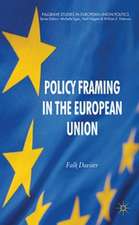The Palgrave Handbook of the European Administrative System: European Administrative Governance
Editat de M. Bauer, J. Trondalen Limba Engleză Hardback – 28 ian 2015
| Toate formatele și edițiile | Preț | Express |
|---|---|---|
| Paperback (1) | 1228.15 lei 43-57 zile | |
| Palgrave Macmillan UK – 28 ian 2015 | 1228.15 lei 43-57 zile | |
| Hardback (1) | 1234.14 lei 43-57 zile | |
| Palgrave Macmillan UK – 28 ian 2015 | 1234.14 lei 43-57 zile |
Din seria European Administrative Governance
- 17%
 Preț: 460.49 lei
Preț: 460.49 lei -
 Preț: 380.07 lei
Preț: 380.07 lei -
 Preț: 385.84 lei
Preț: 385.84 lei -
 Preț: 388.72 lei
Preț: 388.72 lei -
 Preț: 390.63 lei
Preț: 390.63 lei -
 Preț: 385.47 lei
Preț: 385.47 lei -
 Preț: 388.52 lei
Preț: 388.52 lei - 15%
 Preț: 641.53 lei
Preț: 641.53 lei -
 Preț: 388.52 lei
Preț: 388.52 lei -
 Preț: 381.59 lei
Preț: 381.59 lei -
 Preț: 386.00 lei
Preț: 386.00 lei -
 Preț: 386.39 lei
Preț: 386.39 lei - 18%
 Preț: 722.58 lei
Preț: 722.58 lei - 15%
 Preț: 695.34 lei
Preț: 695.34 lei - 18%
 Preț: 1112.48 lei
Preț: 1112.48 lei - 18%
 Preț: 887.83 lei
Preț: 887.83 lei - 15%
 Preț: 703.20 lei
Preț: 703.20 lei - 15%
 Preț: 530.75 lei
Preț: 530.75 lei - 18%
 Preț: 781.00 lei
Preț: 781.00 lei - 15%
 Preț: 522.42 lei
Preț: 522.42 lei - 15%
 Preț: 496.48 lei
Preț: 496.48 lei - 15%
 Preț: 694.22 lei
Preț: 694.22 lei - 18%
 Preț: 786.98 lei
Preț: 786.98 lei - 18%
 Preț: 729.53 lei
Preț: 729.53 lei
Preț: 1234.14 lei
Preț vechi: 1505.05 lei
-18% Nou
Puncte Express: 1851
Preț estimativ în valută:
236.16€ • 247.19$ • 196.55£
236.16€ • 247.19$ • 196.55£
Carte tipărită la comandă
Livrare economică 31 martie-14 aprilie
Preluare comenzi: 021 569.72.76
Specificații
ISBN-13: 9781137339881
ISBN-10: 1137339888
Pagini: 511
Ilustrații: XXI, 511 p.
Dimensiuni: 155 x 235 x 29 mm
Greutate: 0.92 kg
Ediția:2015
Editura: Palgrave Macmillan UK
Colecția Palgrave Macmillan
Seria European Administrative Governance
Locul publicării:London, United Kingdom
ISBN-10: 1137339888
Pagini: 511
Ilustrații: XXI, 511 p.
Dimensiuni: 155 x 235 x 29 mm
Greutate: 0.92 kg
Ediția:2015
Editura: Palgrave Macmillan UK
Colecția Palgrave Macmillan
Seria European Administrative Governance
Locul publicării:London, United Kingdom
Cuprins
1. Introduction: The Administrative System of the European Union; Michael W. Bauer and Jarle Trondal PART I: THEORETICAL PERSPECTIVES 2. European Public Administration as Multilevel System Administration: A conceptual Framework; Arthur Benz 3. The Two Logics of Multilevel Administration in the EU; Edgar Grande and Martina McCowan 4. EU Administration: Center Formation and Multilevelness; Morton Egeberg 5. A Conceptual Account of the European Administrative Space; Jarle Trondal and B. Guy Peters 6. Administrative Styles of EU Institutions; Christoph Knill and Stephan Grohs 7. Administrative Reforms in the European Commission and the Neo-Weberian Model; Edoardo Ongaro PART II; EU'S EXECUTIVE ADMINISTRATION 8. The European Commision: Politics and Administration; Michelle Cini 9. Politicization of the European Commission: When, How and with What Impact?; Miriam Hartlapp 10. The Permanent Commission Bureaucrat; Sara Connolly and Hussein Kassim 11. The Temporary Commission Bureaucrat; ZuzanaMurdoch and Jarle Trondal 12. The European External Action Service (EEAS): The New Kid of the Block; Tannelie Blom and Sophie Vanhoonacker PART III: EU'S PARLIAMENT ADMINISTRATION 13. The European Administration: Organizational Structure and Behavioral Implications; Morten Egeberg, Åse Gornitzka, Jarle Trondal and Mathias Johannessen 14. Officials 'Pre-Cooking' EU Affairs? The Role of EP Officials in the Ordinary Legislative Procedure (OLP); Mathias Dobbels and Christine Neuhold PART IV: EU'S 'INTERGOVERNMENTAL' ADMINISTRATION 15. The EU Council(s) System and Administrative Fusion; Wolfgang Wessels, Peter Valant and Tobias Kunstein 16. the Institutional Context of the European Union's Council System and the International Design of Discretion for Preparatory Agents; Jeffery Lewis PART V: EU'S COURT ADMINISTRATIVE 17. The Court of Justice of the European Union and the European Administrative Space; Herwig C H. Hofman 18. The European Court of Auditors and Its Relationship With NationalIndependent Audit Institutions: The Evolving Audit Function in the EU Multi-Level System; Hartmut Aden PART VI: EU'S SUBORDINATED ADMINISTRATION 19. EU's Subordinated Agency Administration and the Rise of Executive Power at the European Level; Morten Egeberg, Maria Martens and Jarle Trondal 20. Exploring EU Commission-Agency Relationship: Partnership or Parenthood? Nina Merethe Vestlund PART VII: VERTICAL AND HORIZONTAL ADMINISTRATIVE INTERACTION 21. Horizontal Capacity Pooling: Direct, Decentralized, Joint Policy Execution; Eva G. Heidbreder 22. EU Administration and Interaction with International Organizations; Bob Reinalda 23. The Expert-Executive Nexus in the European Administrative System: Expert Groups and the European Commission; Åse Gornitzka and Ulf Sverdrup 24. Comitology: Over 50 Years of Institutional Reforms and Emerging Practices; Gijs Jan Brandsma 25. Subnational Administrations in the EU Multilevel System: Perspectives from the Bureaucratic Elite; Michael W. Bauer and Stefan Becker 26. The Europeanization of Civil Services and Human Resources (HR) Policies; Christoph Demmke PART VIII: CONCLUSIONS AND CHALLENGES 27 . Holding Executive Power to Account: The EU Administration's Accountability Challenge(s); Anchrit Wille 28. The European Administrative System Reassessed; Jarle Trondal
Recenzii
'This Handbook reveals the interlocking organizational, political and multi-level dimensions of the EU's administrative system. The individual chapters enrich our understanding of its distinctive institutional and behavioral aspects; together, they delimit how this emerging administrative order enhances and limits the EU's role as an autonomous policymaker.'
Chris Ansell, University of California, Berkeley, USA
Chris Ansell, University of California, Berkeley, USA
Notă biografică
Hartmut Aden, Berlin School of Economics and Law, Germany Michael W. Bauer, German University of Administrative Sciences, Speyer Stefan Becker, German University of Administrative Sciences, Speyer Arthur Benz, Technische Universität Darmstadt, Germany Gijs Jan Brandsma, University of Utrecht, the Netherlands Michelle Cini, University of Bristol, UK Sara Connolly, University of East Anglia, UK Christoph Demmke, OECD, Paris Mathias Dobbels, Maastricht University, the Netherlands Morten Egeberg, University of Oslo, Norway Edgar Grande, University of Munich, Germany Åse Gornitzka, University of Oslo, Norway Stephan Grohs, University of Konstanz, Germany Miriam Hartlapp, University of Bremen, Germany Eva G. Heidbreder, University of Düsseldorf, Germany Herwig C. H. Hofmann, University of Luxembourg Mathias Johannessen, University of Oslo, Norway. Hussein Kassim, University of East Anglia, Norway Christoph Knill, Ludwig-Maximilians-University of Munich, Germany Martina McCowan, Ludwig-Maximilians-University of Munich, Germany Tobias Kunstein, University of Cologne, Germany Maria Martens, Norwegian Ministry of Foreign Affairs Zuzana Murdoch, University of Bremen, Germany Christine Neuhold, Maastricht University, the Netherlands Edoardo Ongaro, Northumbria University, UK B. Guy Peters, University of Pittsburgh, USA and Zeppelin University, Germany Bob Reinalda, Radboud University Neijmegen, the Netherlands Ulf Sverdrup, Norwegian Institute of International Affairs (NUPI) Jarle Trondal University of Agder, Norway and University of Oslo, Norway Peter Valant, Trans European Studies Policy Association (TEPSA) Sophie Vanhoonacker, Maastricht University, the Netherlands Nina Merethe Vestlund, University of Oslo, Norway Wolfgang Wessels, University of Cologne, Germany Anchrit Wille, Leiden University, the Netherlands
Caracteristici
Tackles pressing questions about the nature of the EU's emerging bureaucracy Draws on research from the administrative sciences and uses organizational, institutional and decision-making theories Highlights that analyzing the patterns and dynamics of the EU's administrative capacities is essential to understand how it shapes European public policy













